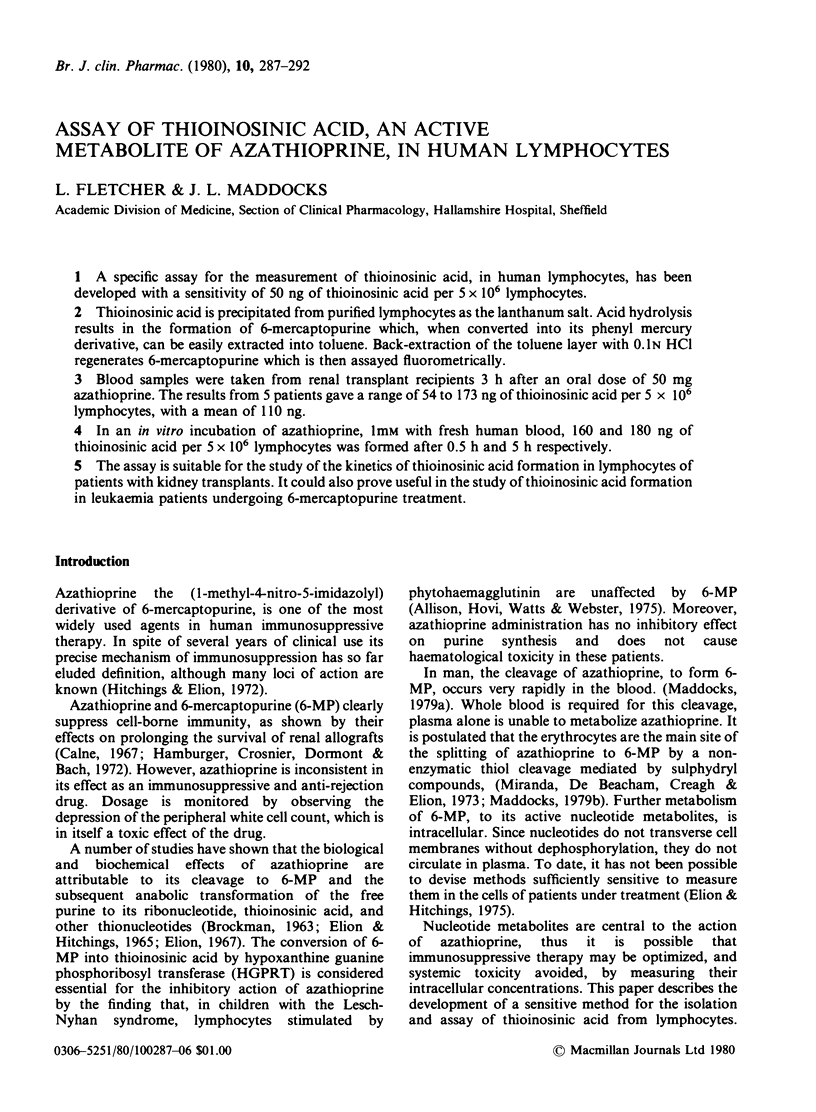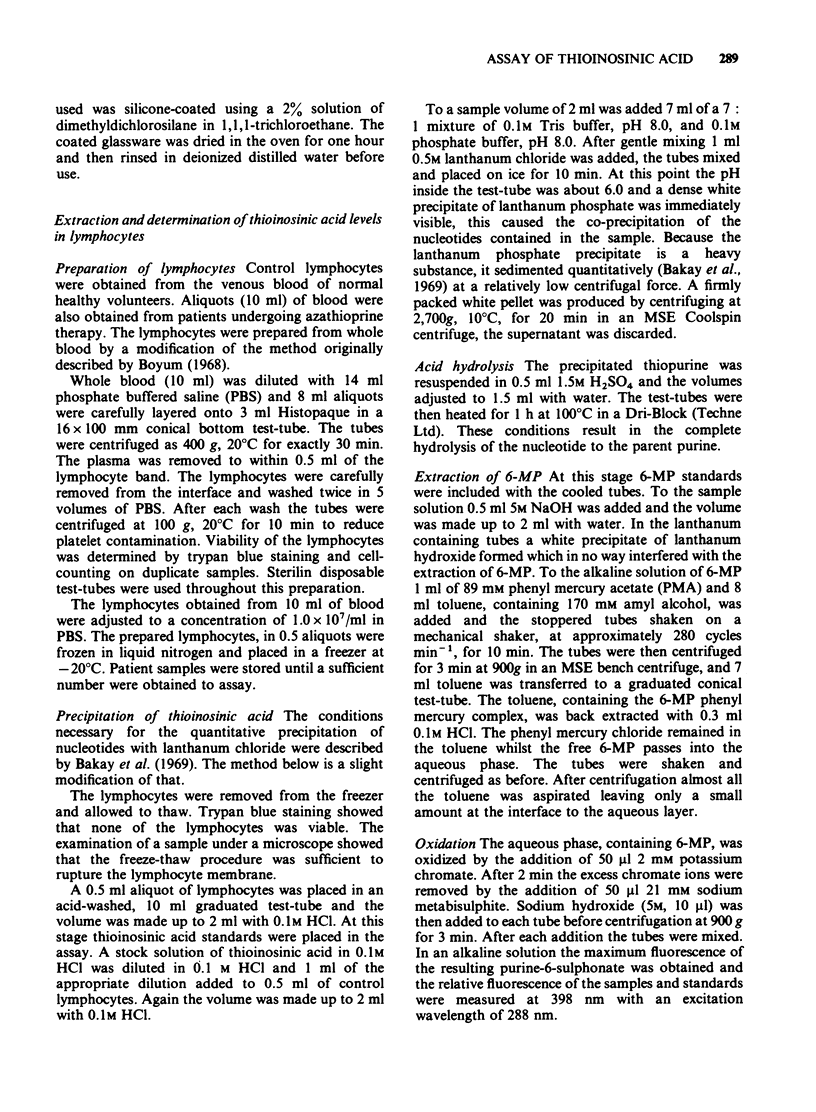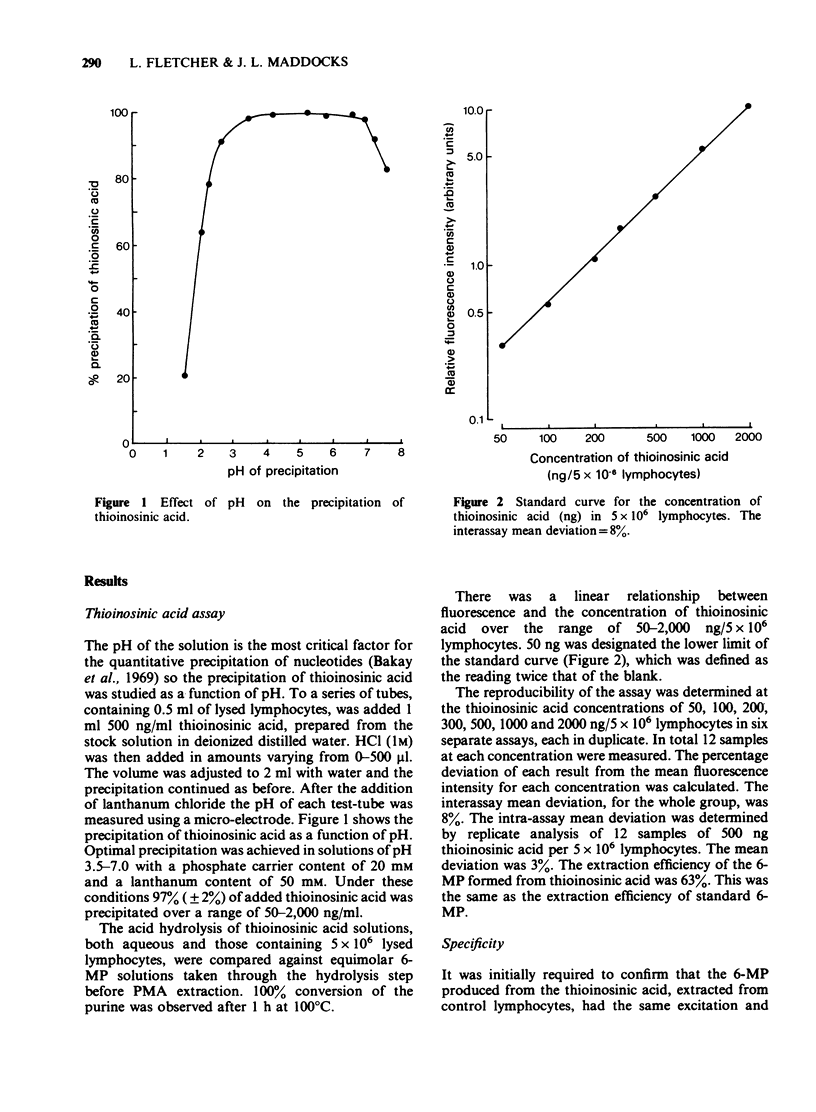Abstract
1 A specific assay for the measurement of thioinosinic acid, in human lymphocytes, has been developed with a sensitivity of 50 ng of thioinosinic acid per 5 x 10(6) lymphocytes. 2 Thioinosinic acid is precipitated from purified lymphocytes as the lanthanum salt. Acid hydrolysis results in the formation of 6-mercaptopurine which, when converted into its phenyl mercury derivative, can be easily extracted into toluene. Back-extraction of the toluene layer with 0.1N HCl regenerates 6-mercaptopurine which is then assayed fluorometrically. 3 Blood samples were taken from renal transplant recipients 3 h after an oral dose of 50 mg azathioprine. The results from 5 patients gave a range of 54 to 173 ng of thioinosinic acid per 5 x 10(6) lymphocytes, with a mean of 110 ng. 4 In an in vitro incubation of azathioprine, 1mM with fresh human blood, 160 and 180 ng of thioinosinic acid per 5 x 10(6) lymphocytes was formed after 0.5 h and 5 h respectively. 5 The assay is suitable for the study of the kinetics of thioinosinic acid formation in lymphocytes of patients with kidney transplants. It could also prove useful in the study of thioinosinic acid formation in leukaemia patients undergoing 6-mercaptopurine treatment.
Full text
PDF





Selected References
These references are in PubMed. This may not be the complete list of references from this article.
- Allison A. C., Hovi T., Watts R. W., Webster A. D. Immunological observations on patients with Lesch-Nyhan syndrome, and on the role of de-novo purine synthesis in lymphocyte transformation. Lancet. 1975 Dec 13;2(7946):1179–1183. doi: 10.1016/s0140-6736(75)92661-6. [DOI] [PubMed] [Google Scholar]
- BROCKMAN R. W. MECHANISMS OF RESISTANCE TO ANTICANCER AGENTS. Adv Cancer Res. 1963;7:129–234. doi: 10.1016/s0065-230x(08)60983-5. [DOI] [PubMed] [Google Scholar]
- Böyum A. Isolation of mononuclear cells and granulocytes from human blood. Isolation of monuclear cells by one centrifugation, and of granulocytes by combining centrifugation and sedimentation at 1 g. Scand J Clin Lab Invest Suppl. 1968;97:77–89. [PubMed] [Google Scholar]
- Caldwell I. C. Ion-exchange chromatography of tissue nucleotides. J Chromatogr. 1969 Oct 28;44(2):331–341. doi: 10.1016/s0021-9673(01)92544-0. [DOI] [PubMed] [Google Scholar]
- De MIRANDA P., Beacham L. M., 3rd, Creagh T. H., Elion G. B. The metabolic fate of the methylnitroimidazole moiety of azathioprine in the rat. J Pharmacol Exp Ther. 1973 Dec;187(3):588–601. [PubMed] [Google Scholar]
- Elion G. B., Hitchings G. H. Metabolic basis for the actions of analogs of purines and pyrimidines. Adv Chemother. 1965;2:91–177. doi: 10.1016/b978-1-4831-9930-6.50008-3. [DOI] [PubMed] [Google Scholar]
- Elion G. B. Symposium on immunosuppressive drugs. Biochemistry and pharmacology of purine analogues. Fed Proc. 1967 May-Jun;26(3):898–904. [PubMed] [Google Scholar]
- Maddocks J. L. Assay of azathioprine, 6-mercaptopurine and a novel thiopurine metabolite in human plasma. Br J Clin Pharmacol. 1979 Sep;8(3):273–278. doi: 10.1111/j.1365-2125.1979.tb01014.x. [DOI] [PMC free article] [PubMed] [Google Scholar]
- Maddocks J. L., Davidson G. S. Separation and detection of picomole quantities of azathioprine metabolites. Br J Clin Pharmacol. 1975 Aug;2(4):359–360. doi: 10.1111/j.1365-2125.1975.tb02785.x. [DOI] [PMC free article] [PubMed] [Google Scholar]
- Nelson D. J., Bugge C. J., Krasny H. C., Zimmerman T. P. Separation of 6-thiopurine derivatives on DEAE-sephadex columns and in the high-pressure liquid chromatograph. J Chromatogr. 1973 Mar 14;77(1):181–190. doi: 10.1016/s0021-9673(00)93946-3. [DOI] [PubMed] [Google Scholar]
- PATERSON A. R. The formation of 6-mer captopurine riboside phosphate in ascites tumor cells. Can J Biochem Physiol. 1959 Aug;37(8):1011–1023. [PubMed] [Google Scholar]


